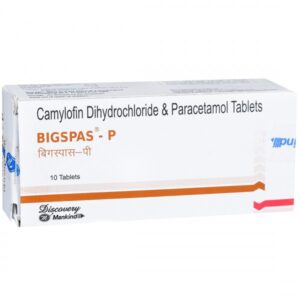CAMYLOFIN + PARACETAMOL
Camylofin: Camylofin is a type of medication that is commonly used to treat a variety of conditions such as stomach cramps, intestinal spasms, and irritable bowel syndrome. It is classified as an antispasmodic drug.
The mechanism of action of Camylofin involves relaxing the smooth muscles in the gastrointestinal tract. It works by blocking certain chemical receptors, such as muscarinic receptors, which are responsible for the contraction of smooth muscles. By inhibiting these receptors, Camylofin helps to relieve spasm and reduce pain associated with smooth muscle contractions.
Camylofin is usually available in the form of tablets or injections. The appropriate dosage may vary depending on the individual and the specific condition being treated. It is important to follow the instructions provided by your healthcare provider or the medication label. Generally, the recommended starting dose for adults is 50-100 mg taken orally, 3-4 times a day. However, the dose may be adjusted based on the response to treatment and any side effects experienced.
As with any medication, Camylofin can cause certain side effects. Common side effects may include dry mouth, blurred vision, dizziness, drowsiness, headache, and skin rash. These side effects are usually mild and temporary. However, if any of these side effects persist or worsen, it is important to seek medical attention. Rarely, more serious side effects such as difficulty breathing or swallowing, chest pain, and irregular heartbeat may occur. If any severe side effects occur, immediate medical attention should be sought.
It is important to note that Camylofin should only be taken under the guidance and prescription of a healthcare professional. They will determine if it is the appropriate medication for your condition and will provide you with the correct dosage and instructions for use.
Paracetamol: Paracetamol, also known as acetaminophen, is a commonly used over-the-counter medication for pain relief and fever reduction. It is also available as a prescription medication in higher doses for the management of moderate to severe pain.
Paracetamol works primarily by inhibiting the synthesis of prostaglandins, which are chemicals in the body responsible for generating pain and fever. It is believed to work mainly in the central nervous system, reducing the perception of pain and lowering elevated body temperature.
The usual adult dose of paracetamol for pain relief is 500 to 1000 milligrams (mg) every 4 to 6 hours, with a maximum daily dose of 4000 mg. For fever reduction, the dose ranges from 325 to 1000 mg every 4 to 6 hours, with a maximum of 3000 mg per day. The recommended doses for children depend on their weight.
Paracetamol is generally well-tolerated, but like any medication, it can have side effects. The most common side effect is liver toxicity, especially when taken in high doses or combined with alcohol. Other possible side effects include allergic reactions, skin rashes, and blood disorders such as methemoglobinemia. It is important to follow the recommended dosage and be cautious if you have liver disease or consume alcohol regularly.
It is essential to note that paracetamol is a different drug from non-steroidal anti-inflammatory drugs (NSAIDs) like aspirin or ibuprofen. While NSAIDs also relieve pain and fever, they work by reducing inflammation through different mechanisms and have different potential side effects.

